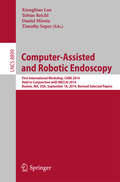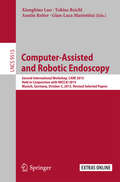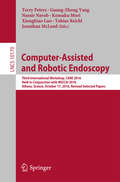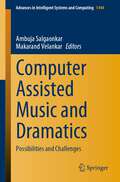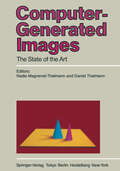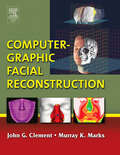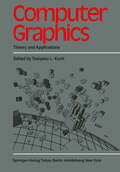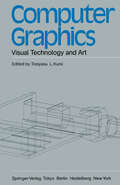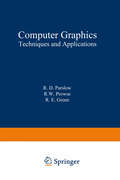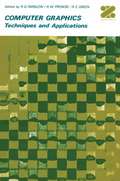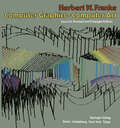- Table View
- List View
Computer Animation ... vom feinsten: Bewegte Computergrafik und hochwertige PC-Animation unter C und Assembler
by Marc SchneiderComputer Applications for Web, Human Computer Interaction, Signal and Image Processing, and Pattern Recognition: International Conferences, SIP, WSE, and ICHCI 2012, Held in Conjunction with GST 2012, Jeju Island, Korea, November 28-December 2, 2012. Proceedings (Communications in Computer and Information Science #342)
by Tai-Hoon Kim Sabah Mohammed Carlos Ramos Jemal Abawajy Byeong-Ho Kang Dominik SlezakThis book comprises the refereed proceedings of the International Conferences, SIP, WSE, and ICHCI 2012, held in conjunction with GST 2012 on Jeju Island, Korea, in November/December 2012. The papers presented were carefully reviewed and selected from numerous submissions and focus on the various aspects of signal processing, image processing, and pattern recognition, and Web science and engineering, and human computer interaction.
Computer Architecture: A Minimalist Perspective (The Springer International Series in Engineering and Computer Science #730)
by William F. Gilreath Phillip A. LaplanteThis book examines computer architecture, computability theory, and the history of computers from the perspective of minimalist computing - a framework in which the instruction set consists of a single instruction. This approach is different than that taken in any other computer architecture text, and it is a bold step. The audience for this book is researchers, computer hardware engineers, software engineers, and systems engineers who are looking for a fresh, unique perspective on computer architecture. Upper division undergraduate students and early graduate students studying computer architecture, computer organization, or embedded systems will also find this book useful. A typical course title might be "Special Topics in Computer Architecture." The organization ofthe book is as follows. First, the reasons for studying such an "esoteric" subject are given. Then, the history and evolution of instruction sets is studied with an emphasis on how modern computing has features ofone instruction computing. Also, previous computer systems are reviewed to show how their features relate to one instruction computers. Next, the primary forms of one instruction set computing are examined. The theories of computation and of Turing machines are also reviewed to examine the theoretical nature of one instruction computers. Other processor architectures and instruction sets are then mapped into single instructions to illustrate the features of both types of one instruction computers. In doing so, the features of the processor being mapped are highlighted.
Computer Architectures: Constructing the Common Ground (Routledge Research in Design, Technology and Society)
by Theodora Vardouli Olga TouloumiComputer Architectures is a collection of multidisciplinary historical works unearthing sites, concepts, and concerns that catalyzed the cross-contamination of computers and architecture in the mid-20th century. Weaving together intellectual, social, cultural, and material histories, this book paints the landscape that brought computing into the imagination, production, and management of the built environment, whilst foregrounding the impact of architecture in shaping technological development. The book is organized into sections corresponding to the classic von Neumann diagram for computer architecture: program (control unit), storage (memory), input/output and computation (arithmetic/logic unit), each acting as a quasi-material category for parsing debates among architects, engineers, mathematicians, and technologists. Collectively, authors bring forth the striking homologies between a computer program and an architectural program, a wall and an interface, computer memory and storage architectures, structures of mathematics and structures of things. The collection initiates new histories of knowledge and technology production that turn an eye toward disciplinary fusions and their institutional and intellectual drives. Constructing the common ground between design and computing, this collection addresses audiences working at the nexus of design, technology, and society, including historians and practitioners of design and architecture, science and technology scholars, and media studies scholars.
Computer Architectures: Constructing the Common Ground (Routledge Research in Design, Technology and Society)
by Theodora Vardouli Olga TouloumiComputer Architectures is a collection of multidisciplinary historical works unearthing sites, concepts, and concerns that catalyzed the cross-contamination of computers and architecture in the mid-20th century. Weaving together intellectual, social, cultural, and material histories, this book paints the landscape that brought computing into the imagination, production, and management of the built environment, whilst foregrounding the impact of architecture in shaping technological development. The book is organized into sections corresponding to the classic von Neumann diagram for computer architecture: program (control unit), storage (memory), input/output and computation (arithmetic/logic unit), each acting as a quasi-material category for parsing debates among architects, engineers, mathematicians, and technologists. Collectively, authors bring forth the striking homologies between a computer program and an architectural program, a wall and an interface, computer memory and storage architectures, structures of mathematics and structures of things. The collection initiates new histories of knowledge and technology production that turn an eye toward disciplinary fusions and their institutional and intellectual drives. Constructing the common ground between design and computing, this collection addresses audiences working at the nexus of design, technology, and society, including historians and practitioners of design and architecture, science and technology scholars, and media studies scholars.
Computer-Assisted and Robotic Endoscopy: First International Workshop, CARE 2014, Held in Conjunction with MICCAI 2014, Boston, MA, USA, September 18, 2014. Revised Selected Papers (Lecture Notes in Computer Science #8899)
by Xiongbiao Luo Tobias Reichl Daniel Mirota Timothy SoperThis book constitutes the refereed proceedings of the First International Workshop on Computer Assisted and Robotic Endoscopy, CARE 2014, held in conjunction with MICCAI 2014, in Boston, MA, USA, in September 2014. The 12 papers presented focus on recent technical advances associated with computer vision; graphics; robotics and medical imaging; external tracking systems; medical device control systems; information processing techniques; endoscopy; planning and simulation.
Computer-Assisted and Robotic Endoscopy: Second International Workshop, CARE 2015, Held in Conjunction with MICCAI 2015, Munich, Germany, October 5, 2015, Revised Selected Papers (Lecture Notes in Computer Science #9515)
by Xiongbiao Luo Tobias Reichl Austin Reiter Gian-Luca MariottiniThis book constitutes the thoroughly refereed post-conference proceedings of the Second International Workshop on Computer Assisted and Robotic Endoscopy, CARE 2015, held in conjunction with MICCAI 2015, in Munich, Germany, in October 2015. The 15 revised full papers were carefully selected out of 20 initial submissions and focus on recent technical advances associated with computer vision; graphics; robotics and medical imaging; external tracking systems; medical device control systems; information processing techniques; endoscopy; planning and simulation.
Computer-Assisted and Robotic Endoscopy: Third International Workshop, CARE 2016, Held in Conjunction with MICCAI 2016, Athens, Greece, October 17, 2016, Revised Selected Papers (Lecture Notes in Computer Science #10170)
by Terry Peters Guang-Zhong Yang Nassir Navab Kensaku Mori Xiongbiao Luo Tobias Reichl Jonathan McLeodThis book constitutes the thoroughly refereed post-conference proceedings of the Third International Workshop on Computer Assisted and Robotic Endoscopy, CARE 2016, held in conjunction with MICCAI 2016, in Athens, Greece, in October 2016. The 11 revised full papers were carefully selected out of 13 initial submissions. The papers are organized on topical secttion such as computer vision, graphics, robotics, medical imaging, external tracking systems, medical device controls systems, information processing techniques, endoscopy planning and simulation.
Computer Assisted and Robotic Endoscopy and Clinical Image-Based Procedures: 4th International Workshop, CARE 2017, and 6th International Workshop, CLIP 2017, Held in Conjunction with MICCAI 2017, Québec City, QC, Canada, September 14, 2017, Proceedings (Lecture Notes in Computer Science #10550)
by M. Jorge Cardoso Tal Arbel Xiongbiao Luo Stefan Wesarg Tobias Reichl Miguel Ángel González Ballester Jonathan McLeod Klaus Drechsler Terry Peters Marius Erdt Kensaku Mori Marius George Linguraru Andreas Uhl Cristina Oyarzun Laura Raj ShekharThis book constitutes the refereed joint proceedings of the 4th International Workshop on Computer Assisted and Robotic Endoscopy, CARE 2017, and the 6th International Workshop on Clinical Image-Based Procedures: Translational Research in Medical Imaging, CLIP 2017, held in conjunction with the 20th International Conference on Medical Imaging and Computer-Assisted Intervention, MICCAI 2017, in Québec City, QC, Canada, in September 2017. The 7 full papers presented at CARE 2017 and the 10 full papers presented at CLIP 2017 were carefully reviewed and selected. The papers deal with interventional and diagnostic endoscopy integrating the latest advances in computer vision, robotics, medical imaging and information processing and the development and evaluation of new translational image-based techniques in the modern hospital.
Computer Assisted Music and Dramatics: Possibilities and Challenges (Advances in Intelligent Systems and Computing #1444)
by Ambuja Salgaonkar Makarand VelankarThis book is intended for researchers interested in using computational methods and tools to engage with music, dance and theatre. The chapters have evolved out of presentations and deliberations at an international workshop entitled Computer Assisted Music and Dramatics: Possibilities and Challenges organized by University of Mumbai in honour of Professor Hari Sahasrabuddhe, a renowned educator and a pioneering computational musicologist (CM) of Indian classical music. The workshop included contributions from CM as well as musicians with a special focus on South Asian arts. The case studies and reflective essays here are based on analyses of genres, practices and theoretical constructs modelled computationally. They offer a balanced and complementary perspective to help innovation in the synthesis of music by extracting information from recorded performances. This material would be of interest to scholars of the sciences and humanities and facilitate exchanges and generation of ideas.
Computer Engineering and Technology: 22nd CCF Conference, NCCET 2018, Yinchuan, China, August 15–17, 2018, Revised Selected Papers (Communications in Computer and Information Science #994)
by Weixia Xu Liquan Xiao Jinwen Li Zhenzhen ZhuThis book constitutes the refereed proceedings of the 22nd CCF Conference on Computer Engineering and Technology, NCCET 2018, held in Yinchuan, China, in August 2018.The 17 full papers presented were carefully reviewed and selected from 120 submissions. They address topics such as processor architecture; application specific processors; computer application and software optimization; technology on the horizon.
Computer Facial Animation
by Frederic I. Parke Keith WatersThis comprehensive work provides the fundamentals of computer facial animation and brings into sharper focus techniques that are becoming mainstream in the industry. Over the past decade, since the publication of the first edition, there have been significant developments by academic research groups and in the film and games industries leading to t
Computer Games: 7th Workshop, CGW 2018, Held in Conjunction with the 27th International Conference on Artificial Intelligence, IJCAI 2018, Stockholm, Sweden, July 13, 2018, Revised Selected Papers (Communications in Computer and Information Science #1017)
by Tristan Cazenave Abdallah Saffidine Nathan SturtevantThis book constitutes revised selected papers from the 7th Workshop on Computer Games, CGW 2018, held in conjunction with the 27th International Conference on Artificial Intelligence, IJCAI 2018 in Stockholm, Sweden, in July 2018.The 8 full papers presented in this volume were carefully reviewed and selected from 15 submissions. They cover a wide range of topics related to video games; general game playing.- machine learning and Monte Carlo tree search.
Computer Games As Landscape Art
by Peter NelsonThis book proposes that computer games are the paradigmatic form of contemporary landscape and offers a synthesis of art history, geography, game studies and play. Like paint on canvas, the game engine is taken as the underlying medium, and using the Valve Source Engine as the primary case study, it analyses landscapes according to the technical, economic and cultural features this medium affords. It presents the single-player first-person shooter (Half-Life 2) as a Promethean safari, examines how the economics of gambling and product placement shaped the eSports landscapes of Counter-Strike and reveals how sandboxes such as Garry’s Mod visualise the radical landscape of Web 2.0. This book explores how our relationship to the environment is changing, how we express this through computer games and how we can move beyond examining artistic influences on games to examining how historical connections flow through games and the history of landscape images.
Computer-Generated Images: The State of the Art Proceedings of Graphics Interface ’85
by Nadia Magnenat-Thalmann Daniel ThalmannResearch, development, and applications in computer graphics have dramatically expanded in recent years. Because of decreasing prices, superior hardware is now being used and image quality is better than ever. Many people now require image-synthesis techniques and software for their applicaions. Moreover, the techniques of computer ani mation have become very popular. In this book, we present a wide range of applications of computer graphics. This book is a collection of 44 papers in various areas of computer graphics selected from papers presented at Graphics Interface '85. Graphics Interface '85, held from May 27 to 31 in Montreal, was the first truly international computer graphics conference in Canada. This year, for the first time, the conference was presented jointly by the Com puter Graphics Society and the Canadian Man-Computer Communications Society. This new arrangement gave the conference international scope. The conference was spon sored by the Department of Communications in Ottawa, the Department of Science and Technology in Quebec, Supply and Services Canada, the Natural Sciences and Engineer ing Research Council of Canada, Hydro-Quebec, the "Association Canadienne Fran«aise pour I' Avancement des Sciences", and the Canadian Broadcasting Corpora tion. Graphics Interface '85 was organized by "1'Ecole des Hautes Etudes Commerciales" of the University of Montreal. Over 100 papers were submitted to the conference , but 64 were selected by the inter national program committee for presentation. This book contains new expanded versions of the papers.
Computer-Graphic Facial Reconstruction
by John G. Clement Murray K. MarksThis unique books looks at a cost-efficient, fast and accurate means of facial reconstruction--from segmented, decomposed, or skeletal remains--using computer-graphic and computational means.Computer-Graphic Facial Reconstruction is designed as a valuable resource for those scientists designing new research projects and protocols, as well as a practical handbook of methods and techniques for medico-legal practitioners who actually identify the faceless victims of crime. It looks at a variety of approaches: artificial intelligence using neural networks, case-based reasoning, Baysian belief systems, along with a variety of imaging methods: radiological, CT, MRI and the use of imaging devices.The methods described in this book complement, or may even replace, the less-reliable, more traditional means of securing identification by presumptive means, i.e., recognition of clothing, personal effects and clay reconstruction.- Covers cutting-edge technologies in the context of historical forensic reconstruction methods- Features stellar authors from around the globe- Bridges the areas of computer graphics, animation, and forensic anthropology
Computer Graphics: From Pixels to Programmable Graphics Hardware (Chapman And Hall/crc Computer Graphics, Geometric Modeling, And Animation Ser.)
by Alexey BoreskovComplete Coverage of the Current Practice of Computer GraphicsComputer Graphics: From Pixels to Programmable Graphics Hardware explores all major areas of modern computer graphics, starting from basic mathematics and algorithms and concluding with OpenGL and real-time graphics. It gives students a firm foundation in today's high-performance graphic
Computer Graphics: From Pixels to Programmable Graphics Hardware (Chapman And Hall/crc Computer Graphics, Geometric Modeling, And Animation Ser. #3)
by Alexey Boreskov Evgeniy ShikinComplete Coverage of the Current Practice of Computer GraphicsComputer Graphics: From Pixels to Programmable Graphics Hardware explores all major areas of modern computer graphics, starting from basic mathematics and algorithms and concluding with OpenGL and real-time graphics. It gives students a firm foundation in today's high-performance graphic
Computer Graphics: Developments in Virtual Environments
by Rae EarnshawThe decades of the 1970s and 1980s were a very exciting period of discovery in the field of computer graphics. It was a time when new rendering algorithms, different modeling strategies, clever animation techniques,and significant advances in photorealism were being made. Complementing these software developments, hardware systems were dominated by raster technology and programmers had access to excellent workstations on which to develop their graphics systems. In the 1990s, incredible advances in computer graphics are far surpassing developments made during the last twenty years. Yesterdays computer graphics have given way to todays virtual reality. This volume brings together contributions from internationalexperts on the diverse, yet important, range of topics that impact the design and application of virtual environments. Topics covered include 3-D modeling; new approaches to rendering virtual environments; recent research into the problems of animating and visualizing virtual environments; applications for virtual reality systems; and simulation of complex behaviors. Computer Graphics: Developments in Virtual Environments provides a unique opportunity to examine current practice and expert thinking. It is essential reading for students, practitioners, researchers, or anyone else who wishes to find out more about this exciting area.Provides comprehensive coverage of the latest topics in computer graphics, virtual reality, and human-computer interaction Contributors are international experts in the field Examines many real-world applications in a wide variety of fields
Computer Graphics: Theory and Practice
by Jonas GomesComputer Graphics: Theory and Practice provides a complete and integrated introduction to this area. The book only requires basic knowledge of calculus and linear algebra, making it an accessible introductory text for students. It focuses on conceptual aspects of computer graphics, covering fundamental mathematical theories and models and the inher
Computer Graphics: Theory and Applications
by T. L. KuniiThis book is an extensive treatise on the most up-to-date advances in computer graphics technology and its applications. Both in business and industrial areas as well as in research and development, you will see in this book an incredible devel opment of new methods and tools for computer graphics. They play essential roles in enhancing the productivity and quality of human work through computer graph ics and applications. Extensive coverage of the diverse world of computer graphics is the privilege of this book, which is the Proceedings of InterGraphics '83. This was a truly interna tional computer graphics conference and exhibit, held in Tokyo, April 11-14, 1983, sponsored by the World Computer Grpphics Association (WCGA) and organized by the Japan Management Association (JMA) in coopera'tion' with ·~CM-SIGGRAPH. InterGraphics has over 15 thousands participants. This book consists of seven Chapters. The first two chapters are on the basics of computer graphics, and the remaining five chapters are dedicated to typical appli cation areas of computer graphics. Chapter 1 contains four papers on "graphics techniques". Techniques to generate jag free images, to simulate digital logic, to display free surfaces and to interact with 3 dimensional (3D) shaded graphics are presented. Chapter 2 covers "graphics standards and 3D models" in five papers. Two papers discuss the CORE standard and the GKS standard. Three papers de scribe various 3D models and their evaluations.
Computer Graphics: Visual Technology and Art
by Tosiyasu L. KuniiIn the design of any visual objects, the work becomes much easier if previous designs are utilized. Computer graphics is becoming increasingly important simply because it greatly helps in utilizing such previous designs. Here, "previous designs" signifies both design results and design procedures. The objects designed are diverse. For engineers, these objects could be machines or electronic circuits, as discussed in Chap. 3, ''CA~/CAM. '' Physicians often design models of a patient's organs from computed tomography images prior to surgery or to assist in diagnosis. This is the subject of Chap. 8, "Medical Graphics. " Chapter 7, "Computer Art," deals with the way in which artists use computer graphics in creating beautiful visual images. In Chap. 1, "Computational Geometry," a firm basis is provided for the definition of shapes in designed objects; this is a typical technical area in which computer graphics is constantly making worldwide progress. Thus, the present volume, reflecting international advances in these and other areas of computer graphics, provides every potential or actual graphics user with the essential up-to-date information. There are, typically, two ways of gathering this current information. One way is to invite international authorities to write on their areas of specialization. Usually this works very well if the areas are sufficiently established that it is possible to judge exactly who knows what. Since computer graphics, however, is still in its developmental stage, this method cannot be applied.
Computer Graphics: Techniques and Applications
by Robert D. ParslowAbout four or five years ago one began to hear about the enormous interest being taken in on-line consoles and displays. Nothing much was done with them, but computer men felt that this was the way computing ought to go: one might dispense with cards, and overcome many of the problems of man-machine communication. It quickly appeared that, as with computers, there had been a great under estimation of the amount of work involved, of the difficulties of programming, and of the cost. So it began to emerge that graphics was not the ultimate answer, in spite of superb demonstrations where one might watch a square being converted into a cube and then rotated. But my mind goes back to 1951 and the first computers. There, there were demonstrations of arithmetic speed and storage facility; but not much idea of actual use. However, we now understand how to use computers, and in the last year or two, significant developments in the field of graphics have led to genuine applications, and economic benefits. The equipment is still expensive, but it is becoming cheaper, more uses are being found, and f believe that we are just at the stage when the subject is gaining momentum, to become, like computers, a field of immense importance.
Computer Graphics — Computer Art
by Herbert W. FrankeTen years have passed since the first edition of this book, a time sary to stress that the availability of colors further assists artistic span during which all activities connected with computers have ambitions. experienced an enormous upswing, due in particular to the ad The dynamics of display which can be achieved on the screen is vances in the field of semiconductor electronics which facilitated also of significance for the visual arts. It is a necessary condition microminiaturization. With the circuit elements becoming small for some technical applications, for example when simulating er and smaller, i. e. the transition to integrated circuits, the price dynamic processes. Although the graphics systems operating in real time were not designed for artistic purposes, they nonethe of hardware was reduced to an amazingly low level: this has de less open the most exciting aspects to the visual arts. While the finitely been an impulse of great importance to the expansion of computer technology, as well as to areas far removed from tech static computer picture was still a realization in line with the nology.




